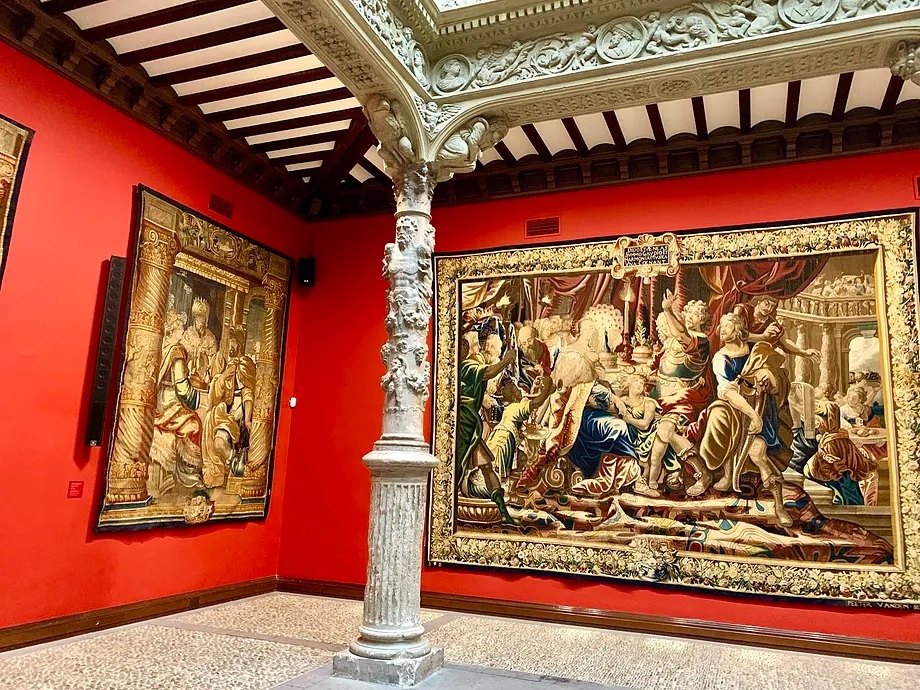He became the royal lender of none other than Carlos I of Spain and V of Germany in the 16th century, so he had to somehow showcase his economic prosperity. And what better way than by building an impressive Renaissance palace in the heart of Zaragoza (calle Nueva, to be precise), where he went to live with his second wife, Sabina de Santángel, to whom he gifted the 1,700 m2 building as a wedding present as a token of love. It is part of the history of the first banker of the Crown of Aragon, Gabriel Zaporta, a converted Jew who became extremely wealthy by exporting products such as wool, saffron, or wheat to other European countries.
Not only did he have money, but also a taste for art and architecture, so he ordered the construction of this Italian-style monument in 1549, an icon of Aragonese Renaissance, where he poured his passion for humanism and mythology into the open-air two-story courtyard, considered the undisputed jewel of the building, now recovered as the headquarters of the Ibercaja Foundation in the city of Zaragoza (calle de San Ignacio de Loyola, 16), where all kinds of events take place, including workshops, talks, concerts, and exhibitions.
There, among balustraded columns, beautiful tapestries made in Flanders by important cartoonists —pay attention to the series of Esther and Ahasuerus signed by Rubens and to that of Dido and Aeneas by Jacob Jordaens— and friezes covered with medallions, you can follow the history of the Roman Empire through the busts of emperors such as Trajan, Hadrian, or Marcus Aurelius. They are accompanied by those of Carlos I (who granted Zaporta the title of noble of Aragon for a reason), Ferdinand the Catholic, and Philip the Handsome. There are also representations of the Three Graces, allegories of Cupid and the wheel of fortune, and the exploits of 14 famous couples like Paris and Helen, Eros and Psyche, Dante Alighieri and Beatrice, and Ulysses and Penelope, which led to the place being known as the Palace of Love in its early days.
In this context, the wood-carved portraits of the financier and his wife could not be missing, guarding their possessions from the top of the gallery on the second floor. The demonstration of their love does not end there, as the man insisted on reflecting the astrological chart of the moment they got married: 6:50 p.m. on June 3, 1549. However, someone has to reveal the discovery to the visitor (there are guided tours of 75 minutes every day by prior reservation), as the lender took great care to hide his kabbalistic beliefs as it was considered heresy at that time.
Unraveling them one by one is the responsibility of Inés González, director of the Patio de la Infanta and its number one fan. "Gabriel Zaporta was passionate about art and astrology, as well as ahead of his time, but he had to present himself as a staunch Christian," says the expert as she points to the marital horoscope that subtly populates the property.
Such cultural significance has made the building an object of desire since its inception. Not in vain, the current name of the courtyard (previously simply called Casa Zaporta) is due to María Teresa de Vallabriga, Countess of Chinchón, wife of Infante Luis de Borbón (brother in turn of King Carlos III), who resided there from 1785, when, already a widow, she decided to settle in her native Zaragoza after a time in the Villa and Court, "turning the place into a meeting point for intellectuals and artists," points out González. Among them, Francisco de Goya, illustrious Aragonese, who immortalized her several times. The painter was also a friend of the merchant Martín de Goicoechea, one of the previous tenants (along with the enlightened Ramón de Pignatelli) of the palace, which housed the Royal Academy of Fine Arts of San Luis, the monarchical and liberal Casino, or the Literary Lyceum.
After decades of decline and a terrible fire in 1894, the courtyard was sold for 17,000 pesetas in 1903 to a French antique dealer, Ferdinand Schultz, who dismantled it and transferred it, piece by piece, to be the showcase of his store on Rue Voltaire in Paris. Over time, there were several interested parties in acquiring it. From the Argentine Evita Perón to the German military officer Hermann Goering, Hitler's right-hand man, but none of them acquired the treasure. In 1958, the heirs of Schultz put it up for sale through the press. After a complicated operation, the Savings Bank of Zaragoza, Aragon, and Rioja (today, Ibercaja) managed to buy it for 30 million francs in a feat that fills the people of Zaragoza with pride in particular and art lovers in general.
